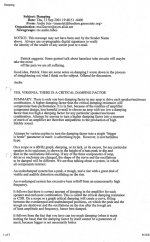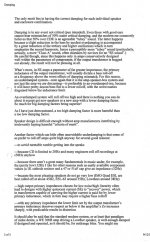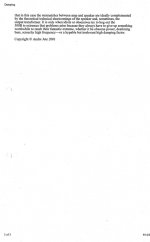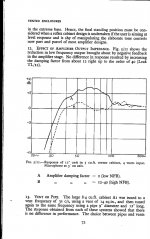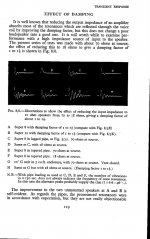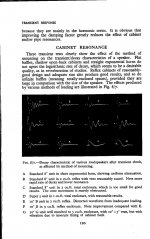When the DF drops below about 20 it will modify the Qes of the driver enough to justify a cabinet re-design from the new Qts (from the high series Re).
If the cabinet gives a behavior of a second order high-pass filter (closed box or open baffle), you can use a parametric equalizer to retrieve the intended response.
It seems to be an absolutely ignored fact that a second order filter can have its damping manipulated by a parametric equalization.
Lowering the apparent damping Q value of the main resonance
Let's suppose we have a closed box with fc = 50 Hz and Qtc = 1.4.
Using a "bell" pass-band equalization set at f = 50 Hz, Q = 1.4 (bandwidth = 1.0) and -6 dB, the response of the whole will be a transfer function of a Butterworth second high pass filter at 50 Hz (Q = 0.71).
For -9 dB, we'll get a Q = 0.5.
Increasing the apparent damping Q value of the main resonance
Let's suppose we have a closed box with fc = 50 Hz and Qtc = 0.5.
Using a "bell" pass-band equalization set at f = 50 Hz, Q = 0.71 (bandwidth = 1.0) and +3 dB, the response of the whole will be a transfer function of a high Butterworth second high pass filter at 50 Hz (Q = 0.71).
For +6 dB, we'll get a Q = 1.0.
(Q and bandwidths as defined in Rane documents).
With a bit more sophistication, we can also change the apparent resonant frequency. This is known as a transformée, the most known but not the only one, is due to Siegfried Linkwitz and was published in 1978.
You have not quite grasped what I am on about when I talk about negative impedance I do not refer to a near oscillator condition !
I refer to the fact that a moving coil when it overshoots it will turn into a generator
this will cause the amplifier via the feed back network to generate a signal in opposition to the overshoot and this will try to correct said overshoot
the greater the damping factor the greater the correction
this will happen to a greater or lesser extent whatever is in the cicuit
Trev
I refer to the fact that a moving coil when it overshoots it will turn into a generator
this will cause the amplifier via the feed back network to generate a signal in opposition to the overshoot and this will try to correct said overshoot
the greater the damping factor the greater the correction
this will happen to a greater or lesser extent whatever is in the cicuit
Trev
djk, i agree with you. in my original post on this topici said that according to my calculations that a DF of 20 isv all you need.
In point of fact I have worked on "as have others" amplifiers that include the spk cables in the feed back loop i.e 4 wire systems These really will improve the damping effect
I have in my collection a trio (In the states Kenwood ) amplifier that does this the results are outstanding an Idea they promoted in the 80,s toshiba did one with 3 wire its a basic instrumentation idea to cancel the impedance of the spk cables
But as ever lots of good ideas do not catch on
Trev
I have in my collection a trio (In the states Kenwood ) amplifier that does this the results are outstanding an Idea they promoted in the 80,s toshiba did one with 3 wire its a basic instrumentation idea to cancel the impedance of the spk cables
But as ever lots of good ideas do not catch on
Trev
Damping factor
Damping factor is very important!!! On my Speakers Altec 515B the bass disappears when you use, high damping factor Transistor amps. The 515b speaker is very well damped, even with tube amps without feedback there is no boom. Most speaker makers design their speakers to suit high damping factor transistor amps; as that is what most people use.
An article on Damping
Damping factor is very important!!! On my Speakers Altec 515B the bass disappears when you use, high damping factor Transistor amps. The 515b speaker is very well damped, even with tube amps without feedback there is no boom. Most speaker makers design their speakers to suit high damping factor transistor amps; as that is what most people use.
An article on Damping
Attachments
Multi,
you appear to have mixed up two different concepts.
Damping of the Speaker Driver to changes in drive signal.
Adjustment of the LF response by changing the Q of the assembled speaker and box.
Both of these are changed by changing the Resistance in the cabling from Source to Load.
you appear to have mixed up two different concepts.
Damping of the Speaker Driver to changes in drive signal.
Adjustment of the LF response by changing the Q of the assembled speaker and box.
Both of these are changed by changing the Resistance in the cabling from Source to Load.
So when you say "negative impedance" you don't actually mean negative impedance? What do you mean?latala said:You have not quite grasped what I am on about when I talk about negative impedance I do not refer to a near oscillator condition !
You are describing zero impedance. Is that what you mean by "negative impedance"?I refer to the fact that a moving coil when it overshoots it will turn into a generator
this will cause the amplifier via the feed back network to generate a signal in opposition to the overshoot and this will try to correct said overshoot
the greater the damping factor the greater the correction
this will happen to a greater or lesser extent whatever is in the cicuit
What is the use of high damping factor of an amplifier, if the passive crossover does everything to nothing again?
Old topic, a thousand times chewed through ... 🙄
Old topic, a thousand times chewed through ... 🙄
True enough, such an inductor tends to have considerable series resistance. But one would hope that the speaker designer took that into account in the design phase and increased mechanical damping accordingly.
As far as I'm concerned, I'd just treat the speaker as a "black box" with frequency-variable impedance that - usually - expects approximately zero output impedance, and just look at what happens at the amplifier-speaker interface. Impedance response is likely to change somewhat as nonlinearities come into play at higher powers, but I'm not sure to which degree that would be relevant.
As far as I'm concerned, I'd just treat the speaker as a "black box" with frequency-variable impedance that - usually - expects approximately zero output impedance, and just look at what happens at the amplifier-speaker interface. Impedance response is likely to change somewhat as nonlinearities come into play at higher powers, but I'm not sure to which degree that would be relevant.
Amplifier and speaker Damping
Some practical examples of the effect of Amplifier and speaker damping from the 1950’s, “Sound reproduction” BY GA Briggs.
Speaker damping is affected by magnet size and quality, design of the voice coil and type of box.
Very long speaker wires will also have some affect.
Some people love the Bass Bloom you get by using low damping factor Tube amps and poor speaker damping. Nothing wrong with that!!
Phil
Some practical examples of the effect of Amplifier and speaker damping from the 1950’s, “Sound reproduction” BY GA Briggs.
Speaker damping is affected by magnet size and quality, design of the voice coil and type of box.
Very long speaker wires will also have some affect.
Some people love the Bass Bloom you get by using low damping factor Tube amps and poor speaker damping. Nothing wrong with that!!
Phil
Attachments
I get the impression that we are moving in circles here. May we for a minute forget about the term "damping factor"; it has been explained in simple electrical terms that it is meaningless and why.
If one may then rather talk of 'damping', it has been established that it occurs because the voice coil generates a back-emf or 'braking current', the magnitude of which will be limited by the total resistance in the driver circuit. Thus far I have not seen any disagreement with this - if so, folks must kindly explain such. (Still, I get the impression that this has been ignored.)
If one may further simplify by simply looking at resistance values instead of the more real impedances (one thing at a time), let us then perhaps see what the actual behaviour is with the following as examples:
For the first exaqmple (8 ohm system), and if I may take a round figure of 6 ohm as typical voice coil wire resistance, I calculate that a damping figure of 8/6,058 or 1,321 is relevant.
For the 4 ohm system, if one may take a round figure of 3 ohm as voice coil wire resistance, I calculate a damping figure of 4/3,168 or 1,263.
This gives a difference of some 4,6% between these two examples. Must I understand that this (or anything similar) is going to make an audible difference?
Again, for 8 ohms, an amplifier + cable resistance of zero (i.e. perfect) will give a damping figure of 8/6 or 1,333.
For the cable contribution of 'already 17 milliohms', the damping figure would be 8/6,017 or 1,329.
This gives a difference of 0,3%. Again, must one understand that this is of any remote audio implication? Does diminishing returns only start then?
One can insert more accurate values in the above; they will not yield significantly different results. Similar following examples seem to deal with similar differences. How is it at all possible that this magnitude of figures will affect loudspeaker performance in any way?
I am not singling Sgrossklass out for criticism, just using his figures as illustration of the impression I gather from the latest posts. One can carry on ad infinitum with ideas of how DF will/can effect various systems but with due respect, unless the above is first explained, such discussions can only border on the anecdotal.
If one may then rather talk of 'damping', it has been established that it occurs because the voice coil generates a back-emf or 'braking current', the magnitude of which will be limited by the total resistance in the driver circuit. Thus far I have not seen any disagreement with this - if so, folks must kindly explain such. (Still, I get the impression that this has been ignored.)
If one may further simplify by simply looking at resistance values instead of the more real impedances (one thing at a time), let us then perhaps see what the actual behaviour is with the following as examples:
Keeping a particularly mean construction that dips down to 1.5 ohms and goes up to 16 ohms within 0.3 dB across the band mandates that source impedance be no greater than 58 milliohms, or DF ~140 ref. 8 ohms. A well-behaved 4 ohm speaker ranging between 3.2 and 10 ohms would be happy with 168 milliohms, or a DF of 48 ref. 8 ohms (24 ref. 4 ohms).
For the first exaqmple (8 ohm system), and if I may take a round figure of 6 ohm as typical voice coil wire resistance, I calculate that a damping figure of 8/6,058 or 1,321 is relevant.
For the 4 ohm system, if one may take a round figure of 3 ohm as voice coil wire resistance, I calculate a damping figure of 4/3,168 or 1,263.
This gives a difference of some 4,6% between these two examples. Must I understand that this (or anything similar) is going to make an audible difference?
....but the point of diminishing returns is reached when output impedance becomes negligible vs. a typical run of cable... 1 m of AWG14 twin-lead already contributes 17 milliohms, so DF couldn't be greater than 470 ref. 8 ohms at this point.
Again, for 8 ohms, an amplifier + cable resistance of zero (i.e. perfect) will give a damping figure of 8/6 or 1,333.
For the cable contribution of 'already 17 milliohms', the damping figure would be 8/6,017 or 1,329.
This gives a difference of 0,3%. Again, must one understand that this is of any remote audio implication? Does diminishing returns only start then?
One can insert more accurate values in the above; they will not yield significantly different results. Similar following examples seem to deal with similar differences. How is it at all possible that this magnitude of figures will affect loudspeaker performance in any way?
I am not singling Sgrossklass out for criticism, just using his figures as illustration of the impression I gather from the latest posts. One can carry on ad infinitum with ideas of how DF will/can effect various systems but with due respect, unless the above is first explained, such discussions can only border on the anecdotal.
Last edited:
What is the use of high damping factor of an amplifier, if the passive crossover does everything to nothing again?
Old topic, a thousand times chewed through ... 🙄
It's a simple question of control. ...An amp having a good grip on the drivers, that's all. ...Stop on a dime when it's time, and start with verve, aplomb.
No?
It's a simple question of control. ...An amp having a good grip on the drivers, that's all. ...Stop on a dime when it's time, and start with verve, aplomb.
No?
The famous and fabled "Iron Grip of Control" provided by an amplifier's High Damping Factor!
An externally hosted image should be here but it was not working when we last tested it.
Julian Hirsch, we are here!
(To answer your question: No!)
Last edited:
I own a McIntosh amplifier with a DF of 14, it would have been charitable to describe it as 'warm' (or muddy if you're not feeling charitable).
After adding a few bypass caps in the usual locations it still has a DF of 14, but sounds like a brick house in the bass now.
After adding a few bypass caps in the usual locations it still has a DF of 14, but sounds like a brick house in the bass now.
...An amp having a good grip on the drivers, that's all.
Northstar,
Not only are we on almost opposite ends of this planet.. 🙂🙂
I take it we are then also on opposite ends of the topic?
In my post just prior to yours (not going to repeat; as Moschfet said: Old topic, a thousand times chewed through), I tried to indicate that any amplifier specifying a DF of say >10 can have no significant/audible control over driver cone movement. (I think it is fair to assume that such a figure goes for >90% of commercial power amplifiers.)
Your statement seems to disagree with this. Care to explain? What am I having wrong with basic electrical laws?
It is more complicated than that.
dave
Ok, I got it now. 🙂
* Bi-amping or tri-amping?
** If Damping Factor is irrelevant, why are we even talking about it, and then why some people (audio engineers) believe it is important?
Last edited:
If Damping Factor is irrelevant, why are we even talking about it, and then why some people (audio engineers) believe it is important?
Now that is a darn good question!
I cannot reply where totally worthier minds than mine have failed (I mean regarding what people believe). I have simply put forward some basic arithmetic, in which it appears there is some logic as thus far I have not read any refutation of the same .... (Also mind that I mainly have it against the term 'damping factor' as presently defined, not against damping per se within the limitations of my previous explanation.)
On a personal note: It is too **** cold here right now to think straight - but then I think I should not be complaining to you guys in Canada, even though you now have summer! 🙂
- Status
- Not open for further replies.
- Home
- Amplifiers
- Solid State
- Damping Factor of amps
